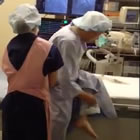| << To Blog Home >> | |
|
|
July 8, 2012 -- 10:30pm PDT Cost Effectiveness of Wrist Angioplasty from Japan
And the results? The transradial wrist approach to catheter-based procedures (angiograms, stents, etc.) was less expensive ($275 per procedure) and resulted in two-thirds less complications than the femoral/groin approach. However, since in the United States, the femoral approach is used in more than 9 out of 10 procedures, and one million such procedures are performed annually, the potential savings to the U.S. healthcare system is in the tens if not hundreds of millions of healthcare dollars. (Important point: the radial approach is used in the majority of diagnostic and interventional procedures in Europe, Canada and Japan -- just not in the U.S.) However, as thorough as the Penn Medicine study was, one cost-savings item wasn't covered in their study: cath lab turn-around time! To be efficient, a high-volume cath lab needs to be able to get patients finished up after their procedure is done. That means hemostasis achieved, vital signs stabilized, patient transferred onto a gurney and into recovery. Then the lab has to be prepped for the next patient, who gets wheeled in on a stretcher, transferred to the table, and the search for the femoral artery and needle puncture is started. Finally, when the needle puncture has been successfully achieved, the next procedure can begin.
So it was with much interest that I received the video below a couple days ago, as I was starting to report on the Penn cost-effectiveness study. The video of the turnaround for radial procedures was shot in the cath lab at Kihara Cardiovascular Hospital in Asahikawa, Hokkaido Japan. The interventional cardiologist doing the procedures is Dr. Shigeru Saito. And the video was shot (and sent to me) by Dutch cardiologist Dr. Ferdinand Kiemeneij, who 20 years ago performed the first PCI from the radial approach, In fact, as the "father of transradial", he was visiting the cath labs in Japan as part of the 20th anniversary celebration of this procedure. (Stay tuned because we'll soon be posting an exclusive interview with Dr. Kiemeneij.) The point, however, of this video is that it runs continuously without editing, showing the time elapsed between removal of the catheter out of the first patient's arm to insertion of the needle in the second patient's arm: 4 minutes and 44 secs. You'll also note in the video that the patients actually get off and on the cath lab table by themselves, because ambulation after a radial procedure is immediate. The implications for fast turn-around time are obvious. And it's comforting to see patients able to climb down off the cath lab table by themselves immediately after the procedure. Here's the video:
|
|


